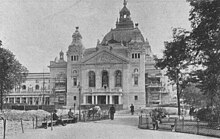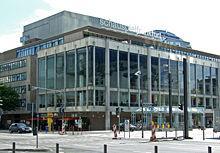Schauspielhaus (Frankfurt am Main)
The Schauspielhaus in Frankfurt am Main is a theater building at the Gallustor that was completed in 1902 . It was considered one of the largest and most important Art Nouveau buildings in Frankfurt on the transition to architectural modernism. Partly destroyed in 1944, most of the original façade was removed in the 1960s and the remaining structure was converted into a modernist building. Parts of the old building are still present on the property. Several clubs are campaigning for the reconstruction of the original playhouse, as the theater is due to be refurbished or relocated anyway.
history
Frankfurt already had a theater in early times. The first was located at today's Rathenauplatz and served as the city's theater from 1782 to 1902. Due to a lack of space, the idea to build a new theater arose.
Playhouse

The theater was built between 1899 and 1902 in the south-western part of the Frankfurt ramparts in Art Nouveau style . The architect of the building was the renowned theater builder Heinrich Seeling . From 1902 to 1944 the building served as a venue for the Frankfurt Theater , a division of the municipal theaters . The interior offered space for 1166 spectators in parquet and three tiers. The stage in turn was 10.5 meters wide. The construction costs amounted to 2.3 million marks. In 1910, the Frankfurt fairy tale fountain was set up next to the theater . 1932 the world premiere of the comedy was here Zero of Fritz von Unruh instead. Next to the playhouse was the Faust wine and beer restaurant , which was connected to the theater building by a colonnade. The buildings formed a coherent ensemble.
The theater burned down in the heavy daytime attack of January 29, 1944 by the United States Army Air Forces , but the shell structure was largely preserved. In 1948 the decision was made to rebuild the building as a makeshift venue for the Frankfurt Opera , as a replacement for the opera house, which was also destroyed in 1944 . In view of other urgent reconstruction projects, the city was initially able and willing to spend little money on restoring the cultural scene.
Big house of the municipal theaters
In early 1950, the reconstruction was stopped by the Frankfurt city council. Only after massive public protests (including around 50,000 signatures for the preservation and reconstruction of the municipal theaters) was the decision to continue building in October 1950. On December 23, 1951, the theater, now called the Great House of the City Theaters , was inaugurated again. From then on it served as a venue for the Frankfurt Opera . Apart from occasional guest appearances on its former stage, the play had to continue to play in the trading hall .
The big house was equipped with the most modern stage technology for the time. The 38-meter-diameter turntable, which also houses a smaller turntable with a 16-meter diameter, is the largest in Europe.
In 1956 the first plans began to expand the large house into a so-called “double theater complex”, which was to combine opera and drama under one roof. In 1960, a new theater was first built for the drama on a neighboring property.
In 1962, the old Art Nouveau facade of the old theater from 1902 was finally knocked off, and its remains disappeared behind a 120-meter-long glass facade that spanned both parts of the building. The sculpture "Goldwolken" by the Hungarian artist Zoltán Kemény (1907–1965) hangs under the ceiling of the foyer - across the entire width of the building . Marc Chagall (1887–1985) painted the painting “Commedia dell'Arte” for the foyer in 1959 on behalf of the city.
In 1963 the new double system was completed. On November 12, 1987, the large house burned down completely in a fire caused by a homeless person. During the time the house was destroyed, the opera was located in the neighboring theater, and the theater in turn in the Bockenheimer Depot . The opera was rebuilt in unchanged form and opened again in 1991.
The panther quadriga

By a happy coincidence, the Panther Quadriga , a gable ornament created by Franz Krüger in 1902 , was preserved. The bronze statue depicts the goddess of victory Nike on a chariot drawn by four panthers . It was dismantled around 1960 during the facade renovation and sold to an interested party in Wehrheim , who sold it on to a scrap dealer in Nieder-Eschbach in the early 1970s . There she was accidentally discovered by a photographer. After an inquiry at the city archives revealed that it was actually the lost quadriga of the theater, the Aktiongemeinschaft Alte Oper acquired the work for 25,000 marks and donated it for the reconstruction of the Alte Oper , whose gable it has been decorating since 1981. The original decoration on the gable of the Alte Oper, a sun chariot of Phöbus Apollon pulled by two griffins , was destroyed in 1944.
literature
The Frankfurter Schauspielhaus from 1912 to 1929 . Berlin, Free Univ., Philos. Fac., Dissertation presented by Dieter Wedel (1965).
Web links
- The reconstruction of the Frankfurt theaters ( Memento from February 4, 2012 in the Internet Archive )
- Historical images at altfrankfurt.com
Individual evidence
- ^ W. Klötzer: Frankfurt formerly, yesterday and today. Steinkopf Verlag, 1985, ISBN 3-7984-0632-4 , p. 133.
Coordinates: 50 ° 6 ′ 29 ″ N , 8 ° 40 ′ 27 ″ E









